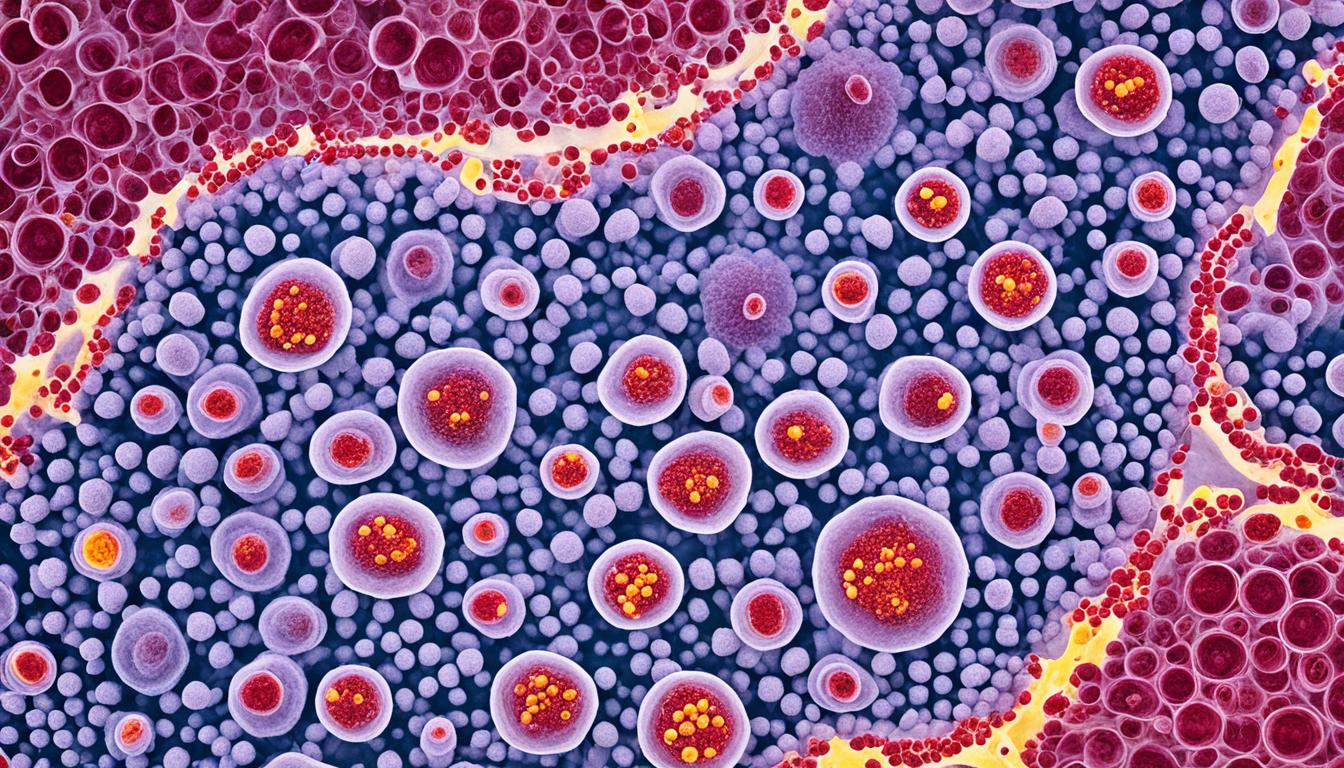Desmoplastic small round cell tumors (DSRCT) affect mostly white boys and men aged 10 to 30. It’s a rare cancer that’s tough to diagnose and treat. Here’s a look at its symptoms, causes, and diagnosis, with a focus on stem cell therapy.
Key Takeaways:
- DSRCT is a rare type of soft tissue sarcoma primarily affecting Caucasian males between the ages of 10 and 30.
- The exact cause of DSRCT is unknown, but it is believed to involve a genetic abnormality related to chromosomes 11 and 22.
- Common symptoms of DSRCT include a solid mass in the abdomen, belly cramps, continued belly pain, constipation, unexplained weight loss, and a painful lump in the belly button.
- Diagnosing DSRCT typically involves a physical examination, biopsy, and imaging tests such as MRI, CT, chest CT, and PET.
- Treatment options for DSRCT may include surgery, radiation therapy, chemotherapy, proton therapy, hyperthermic intra-peritoneal chemotherapy (HIPEC), targeted tumor ablation techniques, and potentially stem cell therapy.
Causes and Risk Factors of DSRCT
Desmoplastic small round cell tumors (DSRCT) are rare cancers. They mostly affect young white males from 10 to 30 years old. The cause of DSRCT is not fully understood yet. But, there’s a likely genetic problem with chromosomes 11 and 22 that can lead to this cancer.
DSRCT seems tied to both genes and the environment. However, we don’t know the specific risks besides the genetic issue. This gap in our understanding means we need to research more about what puts people at risk for DSRCT.
Epidemiology of DSRCT
DSRCT is very uncommon. It’s seen more often in young, white males between 10 and 30. This rarity highlights the importance of knowing who’s at risk. Understanding the disease’s profile helps with finding it early and preventing it.
In Table 1, we share how DSRCT cases are spread by gender and age group:
| Gender | Age Group |
|---|---|
| Male | 10-30 years |
The table data shows how DSRCT cases are not spread equally. This tells us why it’s so important to spread the word and set up screening for those at risk.
Symptoms and Diagnosis of DSRCT
DSRCT usually grows silently. By the time signs show, the tumor might be quite large. The main sign is a lump in the abdomen, leading to pain. Other signs are stomach cramps, constipation, weight loss, and a lump in the belly button.
Doctors perform a physical check carefully if DSRCT is suspected. They look for any unusual signs. Also, they use tests to confirm and check the cancer’s spread.
Diagnosis of DSRCT
A biopsy is crucial for a DSRCT diagnosis. It involves removing a piece of the tumor for lab study. This test reveals the tumor’s specifics, confirming DSRCT.
Imaging tests are also vital for diagnosing DSRCT. They help see the tumor and its condition. For this, doctors commonly use MRI, CT scans, and chest CTs. A PET scan might be used to check for cancer spread.
Biopsy findings are paired with imaging results for a full DSRCT diagnosis. This process guides doctors to the right treatment plan.
Early and accurate diagnosis is key to treating DSRCT effectively. Anyone with warning signs should see a doctor right away. This includes those with an abdominal lump, pain, or unusual weight loss.
Treatment and Prognosis of DSRCT
Desmoplastic small round cell tumors (DSRCT) have several treatment options that focus on the best patient outcomes. These include surgery, radiation therapy, and chemotherapy along with proton therapy, HIPEC, targeted tumor ablation, stem cell therapy, and clinical trials.
Surgery is key in DSRCT treatment, aiming to remove most of the tumor and lower its impact. After surgery, radiation and chemo are used together. Radiation kills cancer cells with high-energy beams. Meanwhile, chemotherapy stops new cells from growing with strong medicines.
If there might be side effects, doctors could suggest proton therapy. This treatment is more precise and only hits the tumors, not the healthy tissue. HIPEC is another method. It sends heated chemo directly to the belly, targeting leftover cancer cells.
Doctors also use treatments that target only the cancer, trying not to harm healthy tissue. Stem cell therapy helps grow new blood cells after intense chemo. And through clinical trials, new methods are being tested, giving hope for future advancements against DSRCT.
Despite all these efforts, DSRCT’s outlook is usually not good. Yet, if a skilled surgeon can take out the whole tumor, it greatly betters the patient’s chances. So, complete surgery by a specialist is crucial for a better outcome against this fast-growing cancer.

